2005 archives (page 2)
January 23, 2005
How to use the Westside Powerlifting Method for Bodybuilding
Westside Barbell is not great news on Dave DePew’s Fitness & Nutrition Hour with a long interview having been done with Louie Simmons (4 Oct 2004) and a segment on using Westside methods for American football with New Jersey Personal Trainer Joe DeFranco (13 Dec 2004). On Thursday, Louie was on again, but this time not on powerlifting but on How to use the Westside Powerlifting Method for Bodybuilding.
The impression I get from this interview is not that Louie is on a crusade to spread the gospel to bodybuilders, but rather has been invited to have his brained ticked on how he would adapt Westside for bodybuilding. Here’s a quick rundown of the interview that gets rolling after a whopping 2:30 minutes of advertisement.
Training cycle
Variety is very important for bodybuilders and the conjugated method should thus be used. Whereas Westside powerlifters would use a different bar every time they squat, bodybuilders do very well with things like doing leg presses at different gyms to hit the muscles from slightly different angles. Training should revolve around a weekly or monthly cycle at most, with nothing done for more than three weeks lest you want your body to stop progressing. “Get the large exercises out of the way first, then move into specifically what you need”.
Reps and sets
A novice bodybuilder would benefit from heavy training, as “powerlifting is basic bodybuilding” and novice bodybuilders will need to have something to cut in the first place - the stronger you are the better a bodybuilder you will be. More advanced bodybuilders would do well training around 70-80% of max.
6 reps for about 5 sets at 70% to build muscle hypertrophy
4 reps for about 5-6 sets at 80%
Stay away from the 90%, no need for it for bodybuilding
Bar speed and bands
Powerlifters generally move the bar quickly, but bodybuilders should move it slowly to eliminate momentum and work the muscle efficiently throughout the motion. Bands should be used, but fought every inch of the way with Louie recommending a 3 second or so eccentric. Tension should be kept on the muscle throughout the set; Louie mentions not allowing IFBB bodybuilder Mike Francois to lock out when he trained at Westside (Francois wrote a short column about training at Westside).
Louie reports having seen great success with using bands together with machines for bodybuilders. In the earlier interview mentioned above, Louie makes the observation that many bodybuilding machines, such as the pec deck, are heaviest at the bottom; here bands can help even out the resistance curve by making the top heavier thus working the muscle harder. In short, bodybuilders should, like powerlifters, continuously think about how to change things even for the same exercise.
Use of partials
Floor press should be used, but Louie recommends against doing too many partials as they can be a bit dangerous, especially board presses (”the only pec injuries we ever incur is doing board press”). The focus should be on full range movements such as benching with different grips.
Waist size
The interview ends with a question on whether the quest for a thin waistline will hinder strength development for bodybuilders. “So you’re not going to get a bodybuilder squat 900 pounds, that’s all there is to it.” There are bodybuilders, such as Ronnie Coleman, who are freaky strong despite having a thin waistline, but they are rather the exception than the rule. Louie recommends a lot of belt squatting and exercises without a bar on the back to keep waist size down. In conclusion, he notes that a lot of bodybuilders have larger waists than they say they do, but the size of their shoulders and legs tends to obscure this fact.
Now, where is the blog dedicated to Westside bodybuilding?
Week 3: Deadlifts and dumbells
Monday, 17 Jan 2005: Squat/Deadlift
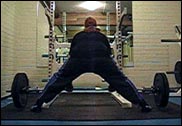 Tried extra hard to sit back on the box squats with some success. Then switched to deadlifts and worked up to a triple at 120 kg/265 lbs before making the decision that I better stop there this week. One step at a time. If the deadlifts weren’t close to a real max, the ultra-wide deads were. I put the collars way out on the bar, then got into an extremely wide sumo stance and pulled for hip and country. I’ve seen this on the Westside tapes, but it was the first time I tried it myself. The stance might have been a bit on the
Tried extra hard to sit back on the box squats with some success. Then switched to deadlifts and worked up to a triple at 120 kg/265 lbs before making the decision that I better stop there this week. One step at a time. If the deadlifts weren’t close to a real max, the ultra-wide deads were. I put the collars way out on the bar, then got into an extremely wide sumo stance and pulled for hip and country. I’ve seen this on the Westside tapes, but it was the first time I tried it myself. The stance might have been a bit on the wide wild side, but the thought that I might end up in a full split did not come to pass. In my martial arts days as an ultra-flexible black belt this would not have been a problem, but now… anyway, first time, first PR at 5 @ 110 kg/243 lbs.
Box squat, 13″ (belt): 5x2 @ 65 kg/144 lbs
Deadlift:
7 @ 60 kg/133 lbs
5 @ 70 kg/155 lbs
3 @ 80 kg/177 lbs
3 @ 90 kg/199 lbs
3 @ 100 kg/221 lbs
3 @ 110 kg/243 lbs
3 @ 120 kg/265 lbs
Ultra-wide deadlift:
5 @ 65 kg/144 lbs
5 @ 75 kg/166 lbs
5 @ 85 kg/188 lbs
5 @ 95 kg/210 lbs
5 @ 105 kg/232 lbs
5 @ 110 kg/243 lbs
Barbell side bend: 3x8 @ 45 kg/99 lbs
Total training time: 85 min
Wednesday, 19 Jan 2005: Bench
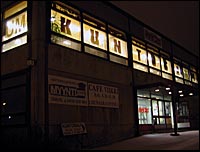 A big banner loudly proclaiming “World Class Gym” in the middle of an industrial area on the way from the school gym to the centre of Helsinki has been attracting the attention of a certain lifting duo. Last week, we finally pulled down from the highway to take a closer look. Turned out to be a medium sized gym part of the Swedish owned World Class franchise that has been there for some 15 years. Famed Finnish bodybuilder Jorma Räty, winner of the 1980 IFBB World Bodybuilding Championship middleweight title, also trains there three times a week (he was in when we were there the first time) - interestingly enough, Räty competed in powerlifting before becoming a bodybuilder and actually won the Nordic Championships in the below 90 kg/199 lbs class in 1969. The machines looked retro in a cool way, but the music was equally retro in a bad way. Supplement prices were several euro cheaper than at the other gyms and the atmosphere was friendly and close-knit. There was no rack to be found, but as we were promised a free try we decided to do today’s training there to conveniently allow me to do some long anticipated dumbell work.
A big banner loudly proclaiming “World Class Gym” in the middle of an industrial area on the way from the school gym to the centre of Helsinki has been attracting the attention of a certain lifting duo. Last week, we finally pulled down from the highway to take a closer look. Turned out to be a medium sized gym part of the Swedish owned World Class franchise that has been there for some 15 years. Famed Finnish bodybuilder Jorma Räty, winner of the 1980 IFBB World Bodybuilding Championship middleweight title, also trains there three times a week (he was in when we were there the first time) - interestingly enough, Räty competed in powerlifting before becoming a bodybuilder and actually won the Nordic Championships in the below 90 kg/199 lbs class in 1969. The machines looked retro in a cool way, but the music was equally retro in a bad way. Supplement prices were several euro cheaper than at the other gyms and the atmosphere was friendly and close-knit. There was no rack to be found, but as we were promised a free try we decided to do today’s training there to conveniently allow me to do some long anticipated dumbell work.
I had to ask some guys how to orientate among the dumbells as I found no markings on them. “Either you count the plates and add 1.4 kg/3.1 lbs for the handles or then try to make sense of the hardly discernable worn-out markings on the rack”. Did a little bit of both. Worked up to a PR double with the 41.6 kg/92 lbs dumbells on the flat bench, which I am quite satisfied with given that I haven’t done these for over a year. Then continued on to dumbell floor presses and was happy to discover that I could both get into position and out of there even with the 39.2 kg/87 lbs bells that I did the last double with.
If the regular clientele wasn’t staring when I worked the dumbells on the floor, the JM presses at least got a few members to pay attention. Followed up with some chest supported rows and then tried a funky looking row machine with the stack; much like the dumbells, the machines had only minimal markings so had no idea what I was repping with. Was pretty beat at this point as I had lived on mostly liquid the whole day - not every day you drink four protein shakes…
Dumbell bench:
5 @ 22.4 kg/50 lbs
5 @ 26.4 kg/58 lbs
5 @ 31.6 kg/70 lbs
4 @ 39.2 kg/87 lbs
2 @ 41.6 kg/92 lbs
Dumbell floor press:
8 @ 23.9 kg/53 lbs
5 @ 28.9 kg/64 lbs
5 @ 34.2 kg/76 lbs
2 @ 39.2 kg/87 lbs
JM press: 6,6,4 @ 50 kg/111 lbs
Chest supported T-bar: worked up to 3x6 @ 65 kg/144 lbs
Seated row machine: 12,10,7 @ whole stack
Total training time: just about an hour
Friday, 21 Jan 2005: Accessory
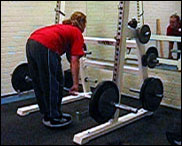 The residue of a sports massage I had at school on Tuesday was mostly gone, but felt quite stiff with humongous chest and triceps soreness from Wednesday’s dumbell session. The biceps were also a bit beat, but did the barbell curls nonetheless before moving into a superset of upper cable turns and incline sit-ups. Wrapped up with stiff-legged deadlifts off the balance board where I worked up to 6 @ 80 kg/177 lbs. By that time, the barbell was actually coming up in a fairly straight line and I no longer looked like I might eject at any time. That’s when the camera was there for this week’s video summary (3.1 MB)
The residue of a sports massage I had at school on Tuesday was mostly gone, but felt quite stiff with humongous chest and triceps soreness from Wednesday’s dumbell session. The biceps were also a bit beat, but did the barbell curls nonetheless before moving into a superset of upper cable turns and incline sit-ups. Wrapped up with stiff-legged deadlifts off the balance board where I worked up to 6 @ 80 kg/177 lbs. By that time, the barbell was actually coming up in a fairly straight line and I no longer looked like I might eject at any time. That’s when the camera was there for this week’s video summary (3.1 MB)
Lying L-flye: 3x7 @ 8 kg/18 lbs
Standing barbell curl with back support: 7,5,6 @ 40 kg/88 lbs
2 supersets:
Upper body cable turn: 2x20 @ 55 kg/122 lbs
Incline sit-up: 15,12
Stiff-legged deadlift on balance board:
6 @ 40 kg/88 lbs
6 @ 50 kg/111 lbs
6 @ 60 kg/133 lbs
6 @ 70 kg/155 lbs
6 @ 80 kg/177 lbs
Total training time: 50 minutes?
January 30, 2005
Week 4: First visit to Metal Gym and GHR Soviet style
Monday, 24 Jan 2005: Squat/Deadlift
Ano Turtiainen, multiple World Champion and manufacturer of the legendary Metal line of equipment, is a household name in powerlifting. His gym, located on the outskirts of Helsinki, is something of a focal hub in Finnish powerlifting as the impressive gym records attest. As one of their lifters wanted to borrow my copy of The Kennelly method, I found myself on a first visit to Metal Gym suitably arranged for SQ/DL day… time to finally make a repping acquaintance with real GHRs and reverse hypers.
Metal Gym turned out to be a tad smaller than I had expected, but with all the goodies a powerlifter could expect. The back of the rectangular gym holds a squatting area equipped with specialty bars, monolift, squat stands, boxes… The chains and bands are conveniently placed as to also be reachable from the adjacent benching and power rack area. A long dumbell rack runs along much of the gym reaching a 71 kg/157 lbs crescendo near the men’s dressing room. Machines, many of them of the Metal brand, and pulleys fill up the rest of the gym with a small stretching area in one corner. There’s also a store selling Metal equipment. It was a surreal feeling to stand in the middle of this metal jungle inhabited by people doing everything from good mornings to accessory work with bands; for once, I wasn’t the only guy doing funny stuff.
After a quick change, I camped around the GHR and reverse hyper. Knowing how hard a GHR was supposed to be, it was with an empty mind that I mounted the machine and placed my feet against the ultra wide toe plate. The motion felt a lot different than the makeshift varieties, whether in lat pulleys or off stability balls, that I have done previously. For one thing, it was hitting my erectors hard since the beginning of a motion is basically an ordinary hyperextension. Secondly, it felt very dynamic and less jarring owing to the knees not being locked into place as on the makeshift varieties. Definitively easier as well, got a surprisingly good 10 reps on the first set in what I hope was good form. Hammies on fire!
In between my GHR sets, I paid attention to how other lifters where using the reverse hyper. After five sets of GHRs, I put my feet into the slings and lay the upper body down on the pad. I had no idea whether the 30 kg/66 lbs the previous lifter had left on the machine would be heavy or light, but figured I would be good to go as I had worked up to more than that on a makeshift setup (video) that by common logic ought to be heavier than the real deal. Following the example of the previous lifters, I swung my legs back and forth rhythmically for 15 easy reps before trying to gracefully get out of this pendulum of sorts. I pyramided up to 60 kg/133 lbs, the most the machine would take using 10 kg/22 lbs plates, which was really heavy on the first rep but easier once I got some momentum. It might look like the whole thing is nothing but momentum, but in fact it takes quite a lot of force to reverse the weight pulling the feet way under the bench (now I understand what it feels like when the discs are opened) and then to actually explode it back up to the top. The last one was an all out set that left my posterior chain feeling pumped to the max. This machine is really as good as they say.
Wrapped up with some ab work. I also got a lot of ideas for accessory work from seeing other lifters pound their midsection with cables and bands. At 5pm, it was rush hour and a lot of heavy squatting and benching was also taking place. After spotting a novice lifter doing 80 kg/177 lbs floor presses, Ano did speed floor presses and board presses in his shirt working up to 7 @ 270 kg/597 lbs (Ano’s log for the day). There was also some clip taking going on as one lifter maxed out on the bench with what I presume was a personal PR.
I’ll be back.
GHR: 10,8,6,6,7
Reverse-hyper:
2x15 @ 30 kg/66 lbs
2x12 @ 40 kg/88 lbs
12 @ 50 kg/111 lbs
12 @ 60 kg/133 lbs
Standing cable crunch against stability ball:
6 @ pin at 7
8,7,9 @ pin at 9
Incline sit-up: 8,7
Total training time: under an hour
Wednesday, 26 Jan 2005: Bench
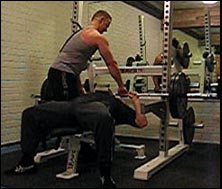 A flop. Based on how run-down I’ve been feeling lately I think I’m very possibly overtrained. Benching 100 kg/221 lbs was already stiff enough and I didn’t stand a chance with 105 kg/232 lbs. The close-grip one board presses went down the same pipe with 100 kg/221 lbs crashing down just short of lockout after a long slow-motion struggle. The thing is that I have been reluctant to take an easy week since our first child is due in two weeks (aka any time). I figure diaper changing is one of the best ways to rejuvenate a fried central nervous system.
A flop. Based on how run-down I’ve been feeling lately I think I’m very possibly overtrained. Benching 100 kg/221 lbs was already stiff enough and I didn’t stand a chance with 105 kg/232 lbs. The close-grip one board presses went down the same pipe with 100 kg/221 lbs crashing down just short of lockout after a long slow-motion struggle. The thing is that I have been reluctant to take an easy week since our first child is due in two weeks (aka any time). I figure diaper changing is one of the best ways to rejuvenate a fried central nervous system.
Bench:
worked up to 1 @ 90 kg/199 lbs
1 @ 100 kg/221 lbs
0 @ 105 kg/232 lbs
1 @ 100 kg/221 lbs (somewhat close grip)
One-board press, close-grip:
worked up to 3 @ 90 kg/199 lbs
0 @ 100 kg/221 lbs
Triceps extension on floor:
2x6 @ 40 kg/88 lbs
12 @ 30 kg/66 lbs
Wide-grip pulldown: 4x15 @ 80 kg/177 lbs
Captains of Crush work
Total training time: approximately an hour
Friday, 28 Jan 2005: Accessory
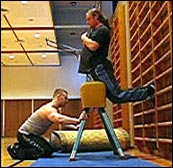 I don’t know why, but it took me a trip to a real GHR bench to remember Louie talking about how the GHR is basically a comfortable version of the original Russian setup that involved a buck horse. Did some surfing around and found this by Wake Forest University Strength Coach Ethan Reeve:
I don’t know why, but it took me a trip to a real GHR bench to remember Louie talking about how the GHR is basically a comfortable version of the original Russian setup that involved a buck horse. Did some surfing around and found this by Wake Forest University Strength Coach Ethan Reeve:
The glute-Ham piece is not a machine. It was designed by a fellow named Michael Yessis. I’m not sure what the name of the manufacturer was but we must have gotten 4 of the first [
was] ones manufactured back in 1984. They were great. Dr. Yessis basically got the idea from the Soviets during the 1970’s with many of their athletes. What they did was put a gymnastic buck horse close to those parallel wooden bars bolted to the wall in many of the gyms. The athlete would then place his belly/hips over the buck horse while placing his feet between the parallel wooden bars and feet against the wall. Some would actually take a [weighted] barbell behind their necks and let themselves down to make a 90 degree bend at the hips and do back raises. Some would raise themselves up beyond parallel by pushing their feet against the wall where they would have to bend the knees and pull themselves up with their hamstrings. A great exercise! [..] Supposedly many of the Soviet athletes would do 50-60 each day before sport training.
Earth calling! Since the school gym is located just below the fully equipped gymnasium trying this setup was easy enough. The only problem was that the buck horse had a tendency to slide away (putting a mat under it didn’t help much) thus making a personal GHR assistant necessary (thanks!). Otherwise it felt nearly exactly the same as doing them on the real deal at Metal Gym. And why wouldn’t it? The ultra wide toe plate (wall), pad (buck horse) and ankle support (parallel bars) are all there. Turns out I should probably have put my feet one notch higher to make the movement a bit harder as I got a good 15 reps on the first set. Then got excited about trying them with a bit of added resistance and worked up to a set with two minibands. If I get too sore for SQ/DL on Monday it was worth it. Anyway, here’s the coveted video of GHRs Soviet style (3.4MB). Feedback welcome.
Speaking of GHR setups, also check out Alberto’s nice makeshift one if you haven’t already (complete with video). If you don’t have an ab board with double rollers, you can always try out Keith Veit’s Floor Glute-Ham Raise involving a barbell for leg support.
GHR Soviet style:
15 @ bodyweight
8 @ miniband
3 @ 2 x miniband
2 supersets:
Incline cable sit-up: 7+1, 5+1 @ 5 kg/11 lbs
Compound stiff-legged dumbell deadlift: 3x20 @ dumbells around 14 kg/31 lbs
Total training time: about 30 minutes
January 31, 2005
Nice logic
Speaking of glute-ham raises, found this important alert over at Kitty’s Consumer Beware! Board.
See the following document that says that the GHR doesn’t kill hair permanently.
http://www.fda.gov/ohrms/dockets/98fr/102698a.txt
So, the GHR is a waste of money.
You have been duly warned.
February 4, 2005
Week 5: Bench and bench only
 This week rolled in with predictably sore hamboys and thus the riot that ensued when the masses demanded a squat workout was violently suppressed. Come Wednesday, I was feeling a bit crappy, but decided to go against the flow with the scheduled bench workout. Turned out my bench was a bit snappier than last week, and I was moderately happy with a new one-board PR of 105 kg/232 lbs. Then went for illegal wides where I felt pathetically weak, probably a sign that I should do a bit more of these… the bar also kept slanting to the right. Feeling more fluish the next day, I did the sensible thing and stayed home from work to nip it in the bud. I should be good to go for a new squat PR off the box on Monday. Until then, here’s the video (3.2MB) that also features Måns doing black belt ninja flies aka suspended dumbell flies.
This week rolled in with predictably sore hamboys and thus the riot that ensued when the masses demanded a squat workout was violently suppressed. Come Wednesday, I was feeling a bit crappy, but decided to go against the flow with the scheduled bench workout. Turned out my bench was a bit snappier than last week, and I was moderately happy with a new one-board PR of 105 kg/232 lbs. Then went for illegal wides where I felt pathetically weak, probably a sign that I should do a bit more of these… the bar also kept slanting to the right. Feeling more fluish the next day, I did the sensible thing and stayed home from work to nip it in the bud. I should be good to go for a new squat PR off the box on Monday. Until then, here’s the video (3.2MB) that also features Måns doing black belt ninja flies aka suspended dumbell flies.
Speed bench: 4x3 @ 50 kg/111 lbs
One-board press:
worked up to 2 @ 90 kg/199 lbs
1 @ 100 kg/221 lbs
1 @ 105 kg/232 lbs
0 @ 107.5 kg/238 lbs
Illegal wides:
5 @ 50 kg/111 lbs
5 @ 60 kg/133 lbs
5 @ 70 kg/155 lbs
3 @ 80 kg/177 lbs
Pressdown in lat pulley:
3 @ 45 kg/99 lbs
2x15 @ 30 kg/66 lbs
Close-grip pulldown: 4x12 @ 80 kg/177 lbs
Total training time: slow
February 18, 2005
Week 6: Band aid for abs and a sudden Metal Militia twist
With most baby preparations now out of the way, but no baby yet, I finally have time to resume my leisurly update schedule. Stay tuned, more to follow… sooner or later [laughter in the dungeon].
Monday, 7 Feb 2005: Squat/Deadlift
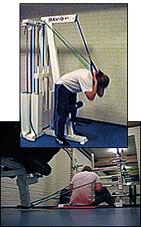 The glorious plan to break my miniscule 13″ box squat PR was foiled by nearly taking a nose dive with a 105 kg/232 lbs that left me feeling a tad worried about what would become of me would this happen with a heavier weight. As you might recall, I was forced out of the rack when I widened my stance. I did 112.5 kg/249 lbs, but feeling how the new PR weight of 117.5 kg/260 lbs wanted to put head over heels I chickened out after a brief lift-off leaving Måns to deadlift it off my back. With two spotters or a decent rack things might have been different, but hey, daddy is still in one piece. That’s indeed something.
The glorious plan to break my miniscule 13″ box squat PR was foiled by nearly taking a nose dive with a 105 kg/232 lbs that left me feeling a tad worried about what would become of me would this happen with a heavier weight. As you might recall, I was forced out of the rack when I widened my stance. I did 112.5 kg/249 lbs, but feeling how the new PR weight of 117.5 kg/260 lbs wanted to put head over heels I chickened out after a brief lift-off leaving Måns to deadlift it off my back. With two spotters or a decent rack things might have been different, but hey, daddy is still in one piece. That’s indeed something.
After a brief Romanian deadlift interlude, I tried Keith Veit’s floor GHR setup involving hooking the feet under a loaded barbell secured by plates at either side to keep it from rolling (or in my case, plates on one side, rack on the other). The gymnasium was occupied by basket ball practice so the excellent GHR Soviet-style was out. Didn’t get further than one rep before I had to make a speedy retreat due to a severe calf cramp. It was then I realized that I had finally found a way of doing spread eagle sit-ups - essentially a straight legged sit-up with legs spread wide that works the hip flexors together with the abs. I’ve tried hooking my feet under everything I could think of, including the parallel bars and the dumbell rack, but everything is at the wrong height or not stable enough (nothing is bolted to the floor). Wrapped two minibands around a bench behind me and had at it. Finished with an exercise I saw over at Metal Gym, namely standing cable crunches with a doubled mini for extra resistance (at Metal they also had a stability ball behind their back and used thicker bands). Besides creating an ideal leverage curve, the bands also make it easy to go as heavy as one wants as the pull is no longer completely from the top - with straight weight I can’t stay put with more than about 45 kg/99 lbs. A great one it is.
Box squat, 13″ (belt):
5x2 @ 65 kg/144 lbs (speed)
worked up to 2 @ 105 kg/232 lbs
1 @ 112.5 kg/249 lbs
0 @ 117.5 kg/260 lbs
Romanian deadlift: 8 @ 80 kg/177 lbs
Spread eagle sit-up:
10,10,8 @ 2 x mini
10 @ mini
Standing cable crunch:
2x8 @ 20 kg/44 lbs + doubled mini
6 @ 45 kg/99 lbs
Total training time: under an hour I hope
Wednesday, 9 Feb 2005: Bench
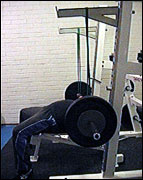 While surfing the Metal Militia headquarters the other day, I stumbled upon Sebastian Burns’s offer to review a benching video for $30. Now, powerlifting is notoriously not where the money is (unless you ask the Nigeria Professional Powerlifting Association), but tell me another sport where you can have a world class lifter review a video tape for this price (Mikesell only asked me for $15 to do the same for the squat - need to see if he is still up for that post-baby). Great help is out there, don’t be afraid to use it!
While surfing the Metal Militia headquarters the other day, I stumbled upon Sebastian Burns’s offer to review a benching video for $30. Now, powerlifting is notoriously not where the money is (unless you ask the Nigeria Professional Powerlifting Association), but tell me another sport where you can have a world class lifter review a video tape for this price (Mikesell only asked me for $15 to do the same for the squat - need to see if he is still up for that post-baby). Great help is out there, don’t be afraid to use it!
Anyway, I fired an e-mail off to Sebastian asking him whether he would consider taking a look at a downloadable video of my raw bench. I figured I would squeeze in a couple of lifts in a short video, but I was positively surprised when he wanted me to “get everything u do for bench” including assistance work on tape. I pulled out all the videos I’ve posted on Under the Bar and put together a package that included all bench work I’ve done over the past two months plus accessory work wherever I could find it. It turned into over 12 minutes of video. Also attached my PR matrix and a short description of my bench progress ripped off the look back at my powerlifting year 2004. A well-organized blog does come in handy at times… Within a few hours I got a reply:
Thanks for taking the time to put that video together it was great to see some of those exercises I have not seen them in years. Your extra work looks good(Back Shoulders)
But your bench work needs much help. You have a very strong work ethic I can tell from the video. If you want to bench more you will need to drop some exercises and concentrate on the ones that will improve your bench the most. You really need to arch a little higher and learn to retract your shoulder blades. If you do not have my bench video I will send you one for free. It will be much easier for you to see what I am talking about than for me to try to convey what I want you to do. I am sending a chart to keep track of the exercises you should be doing. Try both days and send it back with what you did. I will look at it and tell you how I think you should revise your workouts. So send me your address and feel free to call me [..] tommorow so we can discuss your video.
[removed some extra caps from original]
How’s that for a positive reply! At the point of writing I have indeed received a package from Mr. Burns that included a DVD of his Advanced Bench Press Training Video that normally retails for $40. Needless to say, I am deeply honored by this gesture. After a lengthy reply to a second e-mail with questions regarding how I should do the two workouts he sent me to diagnose my weak points, I am starting to wonder how far $30 will stretch with this guy. Not that I am complaining. ![]()
Classified this bench workout as Metal Militia business and set to work going up to a 1-3 RM max on the bench, 4 board, 3 board, 2 board and hangbar (aka hangband) bench. A whopping 28 sets of benching later I was pretty beat and somewhat surprised at being able to put up numbers close to my PRs even after maxing out on several exercises. Intuitively, I would go from low-end work to high-end work, but now I think doing it the Metal Militia way (high-end to low-end) works better. Only having minibands, I did the hangbar bench by doubling them from the supports (see picture). As you can see on this week’s video (7.8MB), this setup required about 35-40 kg/77-88 lbs to touch with very little assistance at the top (empty bar hanging below the end of my stroke). Still, only got a double at 120 kg/265 lbs.
Raw bench:
5 @ 40 kg/88 lbs
3 @ 50 kg/111 lbs
3 @ 60 kg/133 lbs
2 @ 70 kg/155 lbs
1 @ 80 kg/177 lbs
1 @ 90 kg/199 lbs
0 @ 105 kg/232 lbs
1 @ 100 kg/221 lbs
4 board press:
3 @ 60 kg/133 lbs
3 @ 100 kg/221 lbs
3 @ 110 kg/243 lbs
2 @ 120 kg/265 lbs
3 @ 120 kg/265 lbs
2 @ 125 kg/277 lbs
3 board press:
3 @ 60 kg/133 lbs
3 @ 100 kg/221 lbs
1 @ 110 kg/243 lbs
2 @ 110 kg/243 lbs
1 @ 115 kg/254 lbs
2 board press:
3 @ 60 kg/133 lbs
2x2 @ 100 kg/221 lbs
Hangbar bench with doubled minis:
3 @ 100 kg/221 lbs
3 @ 110 kg/243 lbs
2 @ 120 kg/265 lbs
3 @ 115 kg/254 lbs
2 @ 125 kg/277 lbs
Close-grip pulldown: 4x12 @ 90 kg/199 lbs
Total training time: 120 minutes
Week 7: Metal Militia fun continues
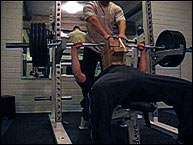 Four days of rest and then back for another 27 sets of Metal Militia diagnostic benching business. Quite frankly, it will be interesting to see what kind of suggestions Sebastian Burns gives and whether he thinks I should be doing a full-blown MM schedule considering my level, my focus on raw benching and my drug-free status. He knows all of this, and I’m willing to give his advice some serious air time and hire him to monitor my benching for a while. Live and learn, you only live once… you know the drill.
Four days of rest and then back for another 27 sets of Metal Militia diagnostic benching business. Quite frankly, it will be interesting to see what kind of suggestions Sebastian Burns gives and whether he thinks I should be doing a full-blown MM schedule considering my level, my focus on raw benching and my drug-free status. He knows all of this, and I’m willing to give his advice some serious air time and hire him to monitor my benching for a while. Live and learn, you only live once… you know the drill.
But back to the workout. Got an easy 100 kg/221 lbs close grip single (looked a lot better than last week’s wide-grip equivalent). Shirt benches were next, but I was told I can skip this since I don’t have a shirt. That being said, I suspect I will need to start to do some shirt benching as I’ve seen Sebastian suggest in the past that raw benchers can indeed be helped by doing some shirt benching as accessory work and he already suggested I get myself a poly or double denim shirt (gulp!).
The six board press was next. This essentially hits the very top of the lockout, and one would be hard pressed to explain why this is not severe ego cheating in a regular gym… As the highest board I have is a four board, we taped the two board to it to prevent a nasty accident were it to slip down on my face butt first. Having done 2 @ 125 kg/276 lbs off the four boards last week, I figured I would be good for about 3 @ 140 kg/309 lbs off the six boards. Whizzed right past that and easily did a triple at 150 kg/332 lbs. Not being used to holding anything that heavy in this position, I felt some strain in my left wrist. Weighed the odds of me sustaining a wrist injury, but then stupidly decided to go ahead ending with a max triple at a whopping 170 kg/376 lbs. Nothing happened to my wrists after I paid some attention to how I was holding the bar, but even in retrospect I can see why loading 70 kg/155 lbs over the regular max on unsuspecting wrists is not the wisest thing to do. Thank you plate curls!
Wrapped up with 2 @ 140 kg/309 lbs off the five board and 2 @ 120 kg/265 lbs off the four board. Having skipped Friday’s accessory day due to intense leg soreness following a PR attempt off the box and figuring this to be the last workout before the baby pops out, I attempted a short SQ/DL session on top of all the benching. Quickly had to conclude that despite two Red Bulls I was too beat. Bag up and home.
Close-grip bench:
10 @ 40 kg/88 lbs
5 @ 50 kg/111 lbs
3 @ 60 kg/133 lbs
2 @ 70 kg/155 lbs
1 @ 80 kg/177 lbs
1 @ 90 kg/199 lbs
1 @ 100 kg/221 lbs
0 @ 105 kg/232 lbs
6 board press:
10 @ 60 kg/133 lbs
4 @ 100 kg/221 lbs
3 @ 110 kg/243 lbs
3 @ 120 kg/265 lbs
3 @ 130 kg/287 lbs
3 @ 140 kg/309 lbs
3 @ 150 kg/332 lbs
3 @ 160 kg/354 lbs
3 @ 170 kg/376 lbs
5 board press:
3 @ 60 kg/133 lbs
3 @ 120 kg/265 lbs
3 @ 130 kg/287 lbs
1 @ 140 kg/309 lbs
2 @ 140 kg/309 lbs
4 board press:
3 @ 60 kg/133 lbs
3 @ 100 kg/221 lbs
3 @ 110 kg/243 lbs
2 @ 120 kg/265 lbs
0 @ 130 kg/287 lbs
Total training time: under two hours ![]()
February 24, 2005
An unforgettable 4kg moment
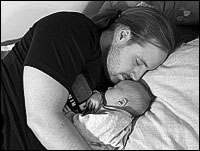 Last Saturday it finally happened. I had prepared for a long labor by stocking up with protein shakes and energy drinks, not to mention some pre-sliced salami. We arrived at the hospital at 1pm, three hours later our son was born powered by no pain medication on Sanna’s part and only a single shake on my part. After being there for Sanna, I have newfound respect for the mothers of this world. Raising the GPP of my delts and changing diapers will be the only exercise I will be up to for the next few days… Happiness is a warm baby. Who cares about PRs?
Last Saturday it finally happened. I had prepared for a long labor by stocking up with protein shakes and energy drinks, not to mention some pre-sliced salami. We arrived at the hospital at 1pm, three hours later our son was born powered by no pain medication on Sanna’s part and only a single shake on my part. After being there for Sanna, I have newfound respect for the mothers of this world. Raising the GPP of my delts and changing diapers will be the only exercise I will be up to for the next few days… Happiness is a warm baby. Who cares about PRs?
Pictures and the rest at the “Norbert” page…
February 26, 2005
Towards lofty theoretical heights
During the twenty-one months I have been powerlifting, my acquisitions have revolved around videos and equipment. A lot of the finer points of technique are still eluding me no doubt, but at this point my repository of technical information appears adequate for my needs - despite not yet being the happy owner of the Elite FTS Exercise Index Squat-Deadlift DVD. Equipment wise, I’m also quite well adjusted to the demands of basic powerlifting training, grip work and rehab (my closet is begging for mercy) . I might need some more bands, and possibly a bench shirt, for accessory work, but the rest (buffalo bar, more Ironmind grip tools…) is icing on the cake rather than immediate requisites. Time to change focus.
Enter reading project. After having gotten most of my theoretical reads from the net in a predigested form, I will now turn to the source and read the main body of the literature that Louie Simmons has used in creating the Westside system. Much of this material comes from the former communist bloc and is based on very rigorous Soviet research on strength training; Sportivny Press claims that the data in their translated Russian manuals “has been gathered from a huge pool of athletes - - over 300,000 weightlifters”. I hope to emerge from my library with a much deepened understanding of strength training and, thus, a much better understanding of my own training. Besides, a book is a great thing to have when you have a sleeping son cuddled up in your lap.
The reading list is based on the Westside FAQ and grouped according to where it is the cheapest to order from to Finland. I will buy used copies when available; get in touch if you have any of the below titles and want to get rid of them. Note that I’m going to strike out titles I’ve purchased and post a comment with the details of every purchase until this project is complete. A rough estimate puts the value of these works at around 400€ without shipping, a cost that appears quite reasonable when distributed over the long haul (I’m hoping to finish this project by end of 2005 the latest). Unfortunately, these items are too specialized to be found in the local public libraries… Here goes:
SSPower (voimaharjoittelu.net)
Supertraining by Siff and VerkhoshanskyAmazon.com
Science and Practice of Strength Training by Zatsiorsky
Science of Sports Training by Kurz
Periodization: Theory and Methodology of Training by Bompa
Power by Hatfield(lots of used copies available dirt cheap)Sportivny Press
Weightlifting Training & Technique by Zhekov
A System of Multi-Year Training in Weightlifting by Medvedyev
A Program of Multi-Year Training in Weightlifting by Medvedyev
The Training of the Weightlifter by Roman
Managing the Training of Weightlifters by Laputin
Fundamentals of Special Strength Training in Sport by Verkhoshansky
Weightlifting Year books 1980-1985
Programming and Organization of Training by VerkhoshanskyOut of print and hard to find
Secrets of Soviet Sports and Fitness Training by Yessis
Periodization of Strength by Bompa
Note that Elite Fitness Systems is not on that list due to their ridiculously high international shipping fees caused by now only providing UPS shipping for their products. As an example, I wanted to order the new Dynamic Bench Manual, but paying $58.64 in shipping for a thin booklet that retails for $16.95 effectively put an end to that (screenshot). When I inquired about this seemingly effective way to thwart international business, I was told that the company dropped the regular airmail option since they were losing too many packages making reshipping them too expensive. I was further told that their ordering system ties directly into UPS, but that they regrettably don’t get any international shipping discounts due to their mail volume being too small (compare regular UPS rates to Amazon’s UPS rates and you’ll see a whopping difference). Of course, I cannot argue with their decision, but I simply cannot afford to be a regular customer of this great company any longer unless I ask someone in the US to order for me and send the merchandise onward ($7.20 for shipping to California sounds much more reasonable, add $5 or so for airmail to Finland). It should also be noted that within the European Union, shipping costs are added to the value of the goods to be imported when determining the import tax thus further escalating this financial violence of sorts when a 22% VAT plus a 3.5% toll fee is slapped on top.
I suspect I am not the only European powerlifter who now turn his eyes towards the EliteFTS reseller in Europe, SSPower here in Finland. The prices are a tad higher, the selection smaller and it generally takes a few weeks for novelties to arrive, but the friendly shipping costs more than makes up for that. Now, SSPower recently started enforcing a 30€ minimum on all orders, but that’s another [minor] rant. In fact, I’m just about to point my browser that way to get my first and most important reading, Supertraining, that just happens to be on a 16€ discount making it a lot cheaper for me than any other sources I know of.
Prepare for a much more theoretical Under the Bar experience!
March 7, 2005
Week 9: Another kind of walk
Rarely a walk goes by without appreciation for the luxury of living at the southern tip of Lauttasaari, an island just west of downtown Helsinki surrounded by the scenic outer archipelago of the Gulf of Finland. Recently, we’ve also realized that Lauttasaari, or Drumsö as we Swedish speaking inhabitants call it, is also home to a host of great restaurants to wither away a couple of weekday evening hours in (the latest addition is a Turkish restaurant just around the corner that goes well with the adjacent sushi place). With life now comprehensively babyfied, the full monty if you please, it was an unexpected pleasure to discover a decent gym buried within the local neighborhood sports center. No rack and seemingly populated by single plate quarter squatters, but excellent for a quick light workout between naps. Nothing strenuous, but boy did it feel great to wield a barbell again!
Deadlift:
10, 5 @ 60 kg/133 lbs
5 @ 70 kg/155 lbs
5 @ 80 kg/177 lbs
5 @ 90 kg/199 lbs
5 @ 100 kg/221 lbs
5 @ 110 kg/243 lbs
Low cable twist: 2x10 @ 30 kg/66 lbs
Bench:
10 @ 40 kg/88 lbs
5 @ 50 kg/111 lbs
5 @ 60 kg/133 lbs
5 @ 70 kg/155 lbs
5 @ 80 kg/177 lbs
Medium parallel-grip pulldown: 2x12 @ 70 kg/155 lbs
Pressdown in lat pulley: 15 @ 30 kg/66 lbs
Total training time: 45 min